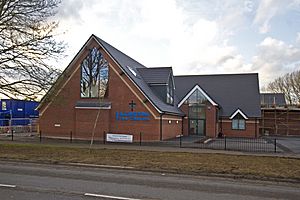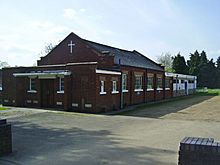Lillington Free Church facts for kids
The Lillington Free Church is a special kind of Christian church. It is located in Lillington, a part of Leamington Spa in England. Unlike some churches, a "free church" is independent and not officially connected to the government.
As of July 2024, the main leader of the church is Reverend Nick Stanyon. He works with elected elders who are chosen by the church members. The church holds regular Sunday worship services. It also has many weekly activities for different ages. These include sunday school, groups like Rainbows, Brownies, and Girl Guides. There are also fun activities like table tennis, coffee mornings, and a toddler cafe.
Even though it is independent, the Lillington Free Church is part of a larger group called the national General Assembly. This group helps guide the church and its minister. The church also has its own magazine, published every three months, called The Link.
Contents
Exploring the Church's History
How the Church Began: The 20th Century
The story of Lillington Free Church started in 1948. At that time, several main "free church" groups in nearby Leamington Spa realized something important. These groups were the Baptists, Methodists, and Congregationalists. They saw a need for more places for people to meet outside the main town area.
The Congregationalists took on the job of setting up a church in Lillington. They quickly bought a piece of land on Cubbington Road for £150. This land was about 1,550 square yards in size. While they were raising money to build a proper church, the Free Church met in a nearby Women's Institute building. Their very first meeting there was on January 6, 1952.
Building the First Church (1954)
In 1953, the church received permission to build on the Cubbington Road site. The plan was for a church that could hold 180 people and would cost £3,000. The first foundation stones were laid on June 27, 1953. The church officially opened for worship on January 30, 1954. The first service was led by its first minister, Reverend D. Gibbons.
This first church building had a main worship area. It also included a foyer (entrance hall), a cloakroom, and toilets at the front. At the back, there was a vestry (a room for the minister) and a kitchen.
Expanding with a New Church (1966)
By 1959, it became clear that the first building was too small. This was especially true for activities like the sunday school. So, a new committee was formed to plan for more space. The church bought more land next to their site for £200. By 1963, they had plans for a much larger new church building.
Work on this new church began on April 10, 1965. The expected cost was £28,000. There was a small delay because of an old gravel pit on the land. However, the first service in the new church took place on September 3, 1966. This new building was much taller than the old one. It had a foyer, cloakroom, toilets, a large main hall, and a vestry. The original 1954 church then became the church hall. Its vestry was removed, and the kitchen was made bigger.
Joining Forces and Sports
On June 21, 1972, two church groups joined together. These were the Congregational Church in England and Wales (who had started the Lillington church) and the Presbyterian Church of England. They formed a new group called the United Reformed Church. Even though Lillington Free Church was now part of this new group, it kept its original name.
That same year, 1972, also saw the start of the Lillington Free Church Table Tennis Club. This club became very successful. Two famous players who came from this club are Commonwealth Games medal winner Kelly Sibley and World Dwarf Games silver medalist Alex O'Driscoll.
Growing the Hall (1974)
By the early 1970s, the 1954 hall was again becoming too small. It was used by the sunday school, Boy Scouts, and Girl Guides, among other groups. So, on March 23, 1974, a large new extension was opened at the back of the hall. This new part included a games room, a coffee bar, a stage area, a small committee room, and new toilets.
The Church Today: The 21st Century
In September 2017, the church received permission to make a big change. The plan was to take down both the 1954 hall and the 1966 church. In their place, a brand new church building would be built. Orbit Homes completed this building work. As part of the agreement, the Free Church gave some of its land to Orbit. Orbit Homes then received permission to build 25 new homes on that land. Some of these homes were planned to be affordable housing.
The very last service in the 1966 church building was held on November 26, 2017. Reverend James Church gave the introduction to this service. The main service was led by Reverend John Carrier, who had been the minister in 1966. The 1966 church was taken down in March 2018. The older 1954 church building was kept and used while the new one was being built.
The first Sunday service in the brand new church building was held on January 20, 2019. The official opening of the new church took place on March 9, 2019. This new church can comfortably hold 80 people. It includes a foyer, toilets, a main hall with a stage, a vestry, an office for the reverend, and a creche or committee room. You can reach the church by public transport using the Stagecoach bus route 67.




